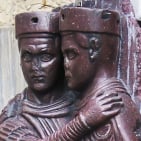A clarification about kerning.

mauro sacchetto
Posts: 353
I take GaramondPremrPro for example.
The glyph of the / I / has: LB 35 and RB 26; the kerning added for the pair / II / is 9pt, so it is symmetrical: 35pt distance between the two serif close together at the bottom.
The glyph of the / E / has: LB 19 and RB 23. The pair / IE / has 9pt of kerning: in this case the two serif close together at the bottom are 54 pt apart.
The glyph of the / A / has: LB 4 and RB 1. The pair / AA / has 10pt of kerning, so that the two close serif below are only 15pt apart.
Are these different distances normal?
At least the couples / II / and / IE / shouldn't be equidistant?
Thank you
Thank you
Tagged:
1
Comments
-
What matters is the optical space between the adjacent letters, not the distance between serif tips. Garamond Premier Pro is closely based on metal types, so has a lot more inconsistencies of serif length and shape than most digital types. If measuring, it is better to do so between the vertical stems of the letters—typically about halfway up the x-height—, rather than looking at sidebearing values.4
-
And what about fonts that don't have vertical stems, like / A / or / O /? Does everything play into what the eye suggests?0
-
Start with numbers, then deviate by eye using smaller numbers.0
-
Round shapes are complicated because unless they are perfectly symmetrical you can't rely on numbers, whether measured from the horizontal extrema or at a standard height. So a letter like O needs to be optically centred between uprights—HHOHH—and then the distance to other rounds checked—HOHOOHOH. That gives you the default spacing for caps against which other letters and kerning are checked. Diagonals complicate things because they produce so much additional white space; however, unlike rounds, it is often possible to use the same measurement on the left and right side taken from the stems at a standard height.
In any font family, one of the first things I do is establish a standard height (usually about halfway up the x-height) at which I make all spacing measurements. This is key to being able to systematise spacing.2 -
In my opinion, kerning should always be optical -- a judgement by eye -- in the final analysis. Particularly with a humanist design like Garamond, numeric measurements are a good place to start and a good sanity check along the way, but one just has to use their eyes and make sure it looks good. And of course that will always be incredibly subjective.
(I assisted with the production of Garamond Premier Pro. Robert Slimbach once asked me to take a pass on kerning a particular font. When I came back with my work, he basically told me it was all wrong and re-did it himself! He saw it all differently than I did.)
It’s tempting to make the sidebearings of a glyph like A equal -- and there’s a decent chance that looks good -- but a serif A probably has a thin stroke and a thick stroke on the left and right, and that might have an uneven optical effect. Again, always use your eye and don’t trust the numbers.7
Categories
- All Categories
- 46 Introductions
- 3.9K Typeface Design
- 487 Type Design Critiques
- 564 Type Design Software
- 1.1K Type Design Technique & Theory
- 656 Type Business
- 861 Font Technology
- 29 Punchcutting
- 520 Typography
- 119 Type Education
- 324 Type History
- 77 Type Resources
- 112 Lettering and Calligraphy
- 33 Lettering Critiques
- 79 Lettering Technique & Theory
- 558 Announcements
- 94 Events
- 114 Job Postings
- 170 Type Releases
- 179 Miscellaneous News
- 276 About TypeDrawers
- 54 TypeDrawers Announcements
- 120 Suggestions and Bug Reports


